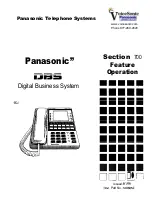
MERLIN LEGEND Communications System Release 5.0
Feature Reference
555-650-110
Issue 1
June 1997
Prior Releases: Features and Enhancements
Page xxiv
Release 4.0 Enhancements
016 Tip/Ring Module
0
This new module supports a 200-extension dial plan by providing 16 ports for
tip/ring devices. Applications that use a tip/ring interface can connect to this
board. All 16 ports can ring simultaneously. Four touch-tone receivers (TTRs) are
included on the module as well. The module’s ringing frequency (default 20 Hz)
can be changed through programming to 25 Hz for those locations that require it.
Downloadable Firmware for the
016 and NI-BRI Modules
0
The Personal Computer Memory Card International Association (PCMCIA)
technology introduced in Release 3.0 continues to support these two new boards
for installation and upgrade in Release 4.0. A Release 3.0 or later processor is
required for PCMCIA technology.
Support for 2B Data Applications
0
A Lucent Technologies-certified group and desktop video application can use two
B-channels to make video/data calls when connected to a single MLX extension
jack programmed for 2B data. The 2B data devices must be equipped with
ISDN-BRI interfaces. NI-1 BRI, PRI, or T1 Switched 56 facilities support 2B data
communications at 112 kbps (using two 56-kpbs channels) or 128 kbps (using two
64-kbps B-channels). This feature is available for Hybrid/PBX and Key modes
only.
Support for T1 Switched 56
Digital Data Transmission
0
For Hybrid/PBX and Key mode systems, Release 4.0 expands support of T1
functionality by providing access to digital data over the public switched 56-kbps
network, as well as to digital data tie-trunk services. Users who have T1 facilities
for voice services can now use them for video or data calls at rates of 56 kbps per
channel (112 kbps for video calls using 2B data). The Release 4.0 offering also
includes point-to-point connectivity over T1 tie trunks, allowing customers to
connect two MERLIN LEGEND Communications Systems or a MERLIN LEGEND
Communications System with a Lucent Technologies DEFINITY® G1.1
Communications System or DEFINITY Enterprise Communications Server. The
two communications systems can be co-located or at different sites.
Forwarding Delay Option
0
Each user can program a Forwarding Delay setting for the Forward, Remote Call
Forwarding, or Follow Me features. The forwarding delay is the number of times
that a call rings at the forwarding extension before the call is sent to the receiver.
The delay period gives the original call recipient time to answer or to screen calls
by checking the displayed calling number (if available). The delay can be set at 0
up to 9 rings. The factory setting for the forwarding delay is 0 rings (no delay).
















































